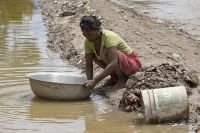Ansel Herz
PORT-AU-PRINCE, Oct 22 2010 (IPS) – Some 1.3 million people have lived in makeshift camps throughout Port-au-Prince since the January earthquake devastated the city. Living conditions are appalling , according a recent report by Refugees International.

Spread through the ingestion of contaminated water, cholera is widely known as a disease of poverty. Credit: UN Photo
But one bright spot of the multi-billion-dollar relief effort, touted by the United Nations and Haitian President Rene Preval, has been the prevention of the spread of a highly infectious, catastrophic disease.
Until now.
At least 160 people have died this week from an outbreak of cholera in the central Artibonite region, according to Zanmi Lasante, the Haitian arm of renowned health organisation Partners in Health.
The fear now is that the disease will reach Port-au-Prince and wreak havoc in the crowded camps by contaminating the water.
There are already six suspected cases of the illness in the capital city, Monica Ferreira, a Portuguese medic, told IPS on Friday. Her team has operated a health clinic for quake victims since January.
Related IPS Articles
All defensive countermeasures should immediately focus on Cite Soleil and Lafiteau if they want to save Port-au- Prince, said Dr. James Wilson of the Haiti Epidemic Advisory System (HEAS).
A HEAS partner reported that a market woman and child died from cholera in the small town of Lafiteau, just 25 kilometres from the capital.
Melinda Miles, director of the Haitian organisation KONPAY, told IPS she witnessed a man die of cholera Friday afternoon at the Hospital Centre of the Haitian Academy in Lafiteau. Doctors at the hospital could not be reached for comment before publication.
We went into the room and he died right in front of us, she said. He came from St. Marc. The doctor said there are a lot more patients on their way with cholera.
If a case from St. Marc has had time to arrive in Lafiteau, then it s had time to arrive in Port-au-Prince. So I m really scared, she added.
The Haitian government says the disease is cholera, a waterborne bacterium that can incubate in bodies for days and suddenly cause death by dehydration. Officials from the Pan American Health Organisation, the regional arm of the Geneva-based World Health Organisation, said Friday that laboratory tests had confirmed the outbreak.
Authorities have rushed medical resources to St. Marc, about 70 kilometres north of Port-au-Prince, where a single hospital is overcrowded with patients. Villagers who traveled from far away are lying on the floors, hooked up to IV drips, while lines amass outside the gate.
Attempting to cope with the overwhelming patient load, a Doctors Without Borders team has moved from the hospital to construct their own treatment centre, spokesperson Petra Becker told IPS.
Other medical teams are gathering information from rural villages to isolate areas where the illness is concentrated and discourage people from moving, she said.
In a blog post on Partners in Health s website, Chief Medical Officer Joia Mukherjee called cholera a disease of poverty . She wrote that loans from the Inter-American Development Bank meant for the development of a public water supply in the Artibonite region were blocked on political grounds during the tenure of President Jean-Bertrand Aristide.
The international community s failure to assist the government of Haiti in developing a safe water supply has been violation of this basic right, Muhkerjee continued.
If the disease reaches Port-au-Prince, the number of victims is likely to skyrocket.
The New York Times reported Friday that cholera cases are surfacing on the island of La Gonave, as well as the areas of Arcahaie and Croix-des Bouquets closer to the capital.
The United Nations and Haitian government are holding emergency meetings in Port-au-Prince to counter the cholera outbreak. Daily truckloads of water delivered by relief group Pure Water for the World to the seaside slum of Cite Soleil have received double the usual chlorination, said Noelle Thabault, the group s deputy director.
Nesly Louissaint, who lives in Camp Carradeux, an officially recognised camp for thousands of quake victims, received a short text message on his cell phone alerting him to the outbreak of the disease. But no authorities have visited the camp with further information, he said.
It s not clear what prevention measures have been taken in the capital city. Traffic, schools, businesses and markets were open Friday and the streets appeared to be bustling as usual.
I have not seen any general information distributed in the streets or camps at this time. I don t see relief groups out here, Mark Snyder, a development worker with International Action Ties, told IPS.
I do see U.N. peacekeeping trucks full of troops, but they are not being utilised to spread information, he continued. They re doing security patrols, which seems like a waste of resources.
Earlier this week, at least 12 people died when heavy rains flooded some of Port-au-Prince s displacement camps. Dr. Wilson warns that October is the peak of Haiti s rainy season, making any further outbreak of the disease more difficult to contain.